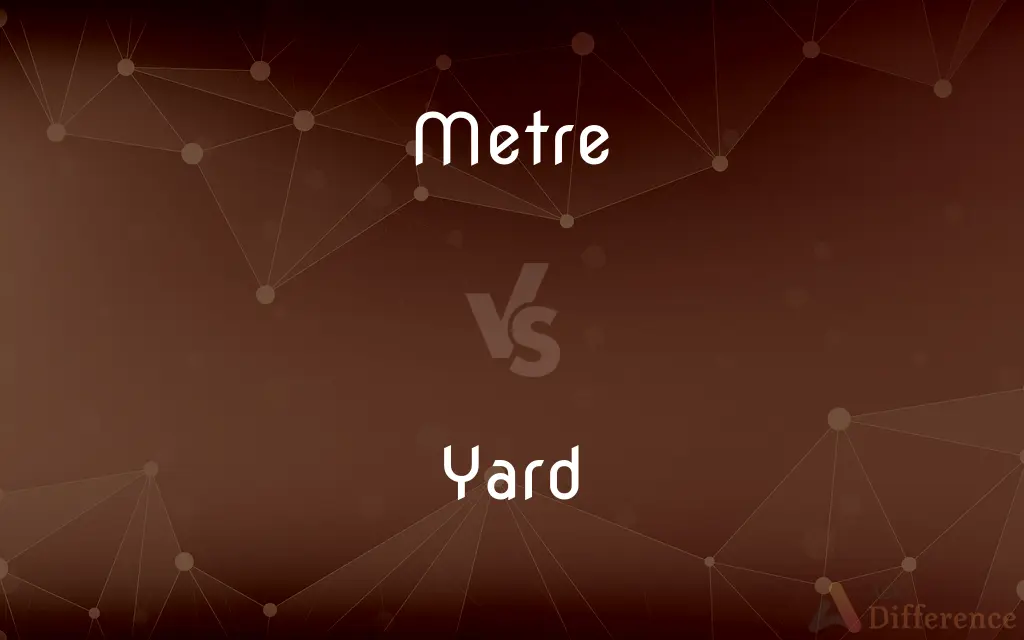Metre vs. Yard — What's the Difference?
By Maham Liaqat & Fiza Rafique — Updated on April 24, 2024
Metre is a metric unit of length equal to 100 centimeters, widely used globally; a yard, equal to 3 feet or 36 inches, is commonly used in the U.S. and U.K.

Difference Between Metre and Yard
Table of Contents
ADVERTISEMENT
Key Differences
A metre is the base unit of length in the International System of Units (SI), standardized as the length of the path travelled by light in a vacuum in 1/299,792,458 of a second. In contrast, a yard is primarily used in the United States and the United Kingdom and is defined as exactly 0.9144 meters.
Metres are widely used in science, engineering, and international commerce due to their global standardization, while yards are often employed in everyday applications such as measuring fabric or field lengths in sports in the U.S. and U.K.
In the realm of precision and universal applicability, metres are preferred because of their integral role in the metric system, which is designed for ease of calculation and conversion. Conversely, yards are part of the imperial system, which is not as conducive to straightforward mathematical operations.
Conversion between metres and yards is common in countries where both systems are in use. For instance, 1 metre is approximately 1.09361 yards. On the other hand, knowing the conversion factor is essential for accurate measurement in engineering and construction projects.
The choice between using metres or yards often comes down to regional preferences and the specific requirements of various fields. In international contexts, metres are generally the standard, while yards remain entrenched in certain countries and specific industries.
ADVERTISEMENT
Comparison Chart
Unit System
Metric
Imperial
Length
1 metre = 100 centimeters
1 yard = 3 feet = 36 inches
Usage
Global, especially in science
Primarily U.S. and U.K.
Conversion
1 metre ≈ 1.09361 yards
1 yard = 0.9144 metres
Standardization
Defined by the speed of light
Historically based on body measures
Compare with Definitions
Metre
Metres are crucial in scientific measurements due to their precision.
The new bridge’s length was calculated in metres for accuracy.
Yard
A yard is a unit of length, equal to 3 feet or 36 inches, used in the imperial system.
The fabric was sold by the yard.
Metre
Metres serve as a basis for all metric units of measure.
The race was a 100 metres sprint.
Yard
In sports, yards are used to measure distances, such as in football.
The player ran 80 yards for a touchdown.
Metre
A metre is the fundamental unit of length in the metric system.
The laboratory table was exactly 2 metres long.
Yard
A yardstick, measuring one yard, is often used for educational purposes.
The teacher used a yardstick to explain the concept of length.
Metre
In everyday language, "metre" can indicate a device measuring different utilities.
Check the parking metre for remaining time.
Yard
Yards are commonly used in the U.K. and U.S. for various measurements.
He walked a couple of yards ahead and stopped.
Metre
Used internationally, a metre equals approximately 39.37 inches.
He measured the width of the door; it was 0.8 metres.
Yard
Yard also refers to an enclosed area around a building.
They played in the yard during recess.
Metre
The metre (Commonwealth spelling) or meter (American spelling; see spelling differences) (from the French unit mètre, from the Greek noun μέτρον, "measure", and cognate with Sanskrit mita, meaning "measured") is the base unit of length in the International System of Units (SI). The SI unit symbol is m.
Yard
The yard (symbol: yd) is an English unit of length, in both the British imperial and US customary systems of measurement, that comprises 3 feet or 36 inches. Since 1959 it is by international agreement standardized as exactly 0.9144 meters.
Metre
Variant of meter1.
Yard
Abbr. yd. A fundamental unit of length in both the US Customary System and the British Imperial System, equal to 3 feet, or 36 inches (0.9144 meter). See Table at measurement.
Metre
Variant of meter2.
Yard
(Nautical) A long tapering spar slung to a mast to support and spread the head of a square sail, lugsail, or lateen.
Metre
The basic unit of length in the International System of Units (SI: Système International d'Unités), equal to the distance travelled by light in a vacuum in 1/299 792 458 seconds. The metre is equal to 127 (approximately 39.37) imperial inches.
Yard
A square yard
Bought 4 yards of fabric.
Metre
The rhythm or measure in verse and musical composition.
Yard
A cubic yard
Dug up 100 yards of soil.
Metre
Alternative spelling of meter
Yard
A tract of ground next to, surrounding, or surrounded by a building or buildings.
Metre
To put into metrical form.
Yard
A tract of ground, often enclosed, used for a specific business or activity.
Metre
See Meter.
Yard
A baseball park.
Metre
The basic unit of length adopted under the Systeme International d'Unites (approximately 1.094 yards)
Yard
An area where railroad trains are made up and cars are switched, stored, and serviced on tracks and sidings.
Metre
(prosody) the accent in a metrical foot of verse
Yard
A somewhat sheltered area where deer or other browsing animals congregate during the winter.
Metre
Rhythm as given by division into parts of equal time
Yard
An enclosed tract of ground in which animals, such as chickens or pigs, are kept.
Yard
To enclose, collect, or put into a yard.
Yard
To gather together into a yard
The deer are yarding up in their winter grounds.
Yard
A small, usually uncultivated area adjoining or (now especially) within the precincts of a house or other building.
Yard
The property surrounding one's house, typically dominated by one's lawn.
Yard
An enclosed area designated for a specific purpose, e.g. on farms, railways etc.
Yard
A place where moose or deer herd together in winter for pasture, protection, etc.
Yard
One’s house or home.
Yard
A unit of length equal to 3 feet in the US customary and British imperial systems of measurement, equal to precisely 0.9144 m since 1959 (US) or 1963 (UK).
Yard
Units of similar composition or length in other systems.
Yard
(nautical) Any spar carried aloft.
Yard
(nautical) A long tapered timber hung on a mast to which is bent a sail, and may be further qualified as a square, lateen, or lug yard. The first is hung at right angles to the mast, the latter two hang obliquely.
Yard
(obsolete) A branch, twig, or shoot.
Yard
(obsolete) A staff, rod, or stick.
Yard
100 dollars.
Yard
(obsolete) The yardland, an obsolete English unit of land roughly understood as 30 acres.
Yard
(obsolete) The rod, a surveying unit of (once) 15 or (now) 2 feet.
Yard
(obsolete) The rood, area bound by a square rod, 4 acre.
Yard
(finance) 109, A short scale billion; a long scale thousand millions or milliard.
I need to hedge a yard of yen.
Yard
(transitive) To confine to a yard.
Yard
To move a yard at a time, as opposed to inching along.
Yard
A rod; a stick; a staff.
If men smote it with a yerde.
Yard
A branch; a twig.
The bitter frosts with the sleet and rainDestroyed hath the green in every yerd.
Yard
A long piece of timber, as a rafter, etc.
Yard
A measure of length, equaling three feet, or thirty-six inches, being the standard of English and American measure.
Yard
A long piece of timber, nearly cylindrical, tapering toward the ends, and designed to support and extend a square sail. A yard is usually hung by the center to the mast. See Illust. of Ship.
Yard
A place where moose or deer herd together in winter for pasture, protection, etc.
Yard
An inclosure; usually, a small inclosed place in front of, or around, a house or barn; as, a courtyard; a cowyard; a barnyard.
A yard . . . inclosed all about with sticksIn which she had a cock, hight chanticleer.
Yard
An inclosure within which any work or business is carried on; as, a dockyard; a shipyard.
Yard
To confine (cattle) to the yard; to shut up, or keep, in a yard; as, to yard cows.
Yard
A unit of length equal to 3 feet; defined as 91.44 centimeters; originally taken to be the average length of a stride
Yard
The enclosed land around a house or other building;
It was a small house with almost no yard
Yard
A tract of land enclosed for particular activities (sometimes paved and usually associated with buildings);
They opened a repair yard on the edge of town
Yard
An area having a network of railway tracks and sidings for storage and maintenance of cars and engines
Yard
An enclosure for animals (as chicken or livestock)
Yard
A unit of volume (as for sand or gravel)
Yard
A long horizontal spar tapered at the end and used to support and spread a square sail or lateen
Yard
The cardinal number that is the product of 10 and 100
Common Curiosities
What industries primarily use yards?
Industries such as textiles, football, and real estate in the U.S. and U.K. predominantly use yards.
What are some common tools for measuring in metres?
Common tools include tape measures, meter sticks, and laser measuring tools, all marked in metric units.
Are metres and yards interchangeable in recipes or cooking?
Metres and yards, being units of length, are not typically used in cooking; volume and weight measurements are more common.
What historical changes have affected the usage of yards?
Historical changes include the international adoption of the metric system by many countries, leading to a decline in the use of the yard outside the U.S. and U.K.
What are some common tools for measuring in yards?
Yardsticks and measuring tapes commonly used in the U.S. and U.K. are tools for measuring in yards.
How did the metre get its definition?
The metre was originally defined in 1791 as one ten-millionth of the distance from the equator to the North Pole along a meridian through Paris.
How do the precision levels of measurements in metres compare to yards?
Measurements in metres are generally considered more precise due to the metric system's reliance on decimal systems, which simplifies calculation and conversion.
Is the metre recognized by the United Nations?
Yes, the metre is recognized by the United Nations and is the standard unit of length for the International System of Units (SI).
How does weather affect measurements in metres and yards?
Measurements in both metres and yards can be affected by extreme temperatures, which can cause materials used for measuring (like metal tapes) to expand or contract.
What legal implications are there in using metres vs yards?
Legal documents concerning land and property in the U.S. and U.K. might require measurements in yards, whereas international agreements typically use metres.
Can the use of metres vs yards affect a scientific experiment's outcome?
Yes, using different units can lead to conversion errors; therefore, using metres, which are part of the SI system, is often encouraged for scientific consistency and accuracy.
How do architects use metres and yards in their work?
Architects working in countries that use the metric system typically use metres in their designs, whereas those in the U.S. might use feet and yards, especially in residential construction.
Are there educational differences in teaching metres and yards?
Yes, countries that use the metric system typically teach measurements in metres from an early age, whereas the U.S. and U.K. focus more on imperial units including yards.
How are road signs different in terms of metres and yards?
In countries using the metric system, road distances and speed limits are in kilometres and metres, whereas in the U.K., road signs use miles and yards.
What role do yards play in cultural expressions or idioms?
In English, especially American English, phrases like "the whole nine yards" use the yard as a measure in cultural expressions, symbolizing completeness or thoroughness.
Share Your Discovery

Previous Comparison
Lychee vs. Rambutan
Next Comparison
Excision vs. ResectionAuthor Spotlight
Written by
Maham LiaqatCo-written by
Fiza RafiqueFiza Rafique is a skilled content writer at AskDifference.com, where she meticulously refines and enhances written pieces. Drawing from her vast editorial expertise, Fiza ensures clarity, accuracy, and precision in every article. Passionate about language, she continually seeks to elevate the quality of content for readers worldwide.














































